|
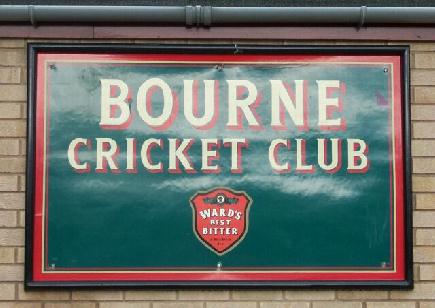
The
sign outside the Abbey Lawn clubhouse
There is evidence that cricket was being played in
the town as early as 1803. A trades exhibition held in the Corn Exchange
in 1962 displayed a poster advertising a return cricket match between
Bourne and Sleaford in the summer of that year followed by lunch at the
Bull Hotel [now the Burghley Arms] at five shillings a head.
A club therefore existed and regular matches were in
progress on a return basis with several local clubs such as Spalding,
Irnham and other villages in the vicinity, games that were always followed
by dinner at a local hostelry. They also attracted a great deal of betting
on the outcome with the result that not all of these fixtures ended in a
friendly atmosphere and there was a particularly acrimonious end to an
encounter between Bourne and Spalding in August 1833 after the home side
wanted to finish the game early but the visitors refused and the dispute
was taken to the Editor of Bell's Life in London, then the agreed arbiter
of the sport.
He subsequently ruled in favour of Bourne saying: "That the Spalding party
could compel the Bourne players to proceed with the game until 8 o'clock
unless a specific agreement was entered into as to what time the stumps
should be drawn. The appointment of an hour for dinner, with the inference
that the play should then terminate for the day, seems not, from this
decision to affect the question. As the evening was cloudy, and the ball
could not be perfectly distinct at that time (16 minutes to 7), the other
party, in common courtesy, might have consented the postpone the match,
more especially as there was no chance of the game's being terminated that
evening, although they could not be compelled to do so."
But the original club did not last and had closed by circa
1850 although occasional games continued with selected teams, such as
married versus single men, and this inspired several attempts to re-form
it which was finally successful in 1857 when the Stamford Mercury
reported on Friday 10th April: "The admirers of the noble game of cricket
will be pleased to learn that powerful efforts have been made for the
reorganisation of the cricket club in this town. Several donations and
subscriptions have been promised and it is arranged to commence the season
this summer."
The opening match was with "The Deepingites, a team from
Market Deeping, arranged for Tuesday 16th June on the Park Ground or Field
[presumably in the
Austerby] and the Bourne Brass Band volunteered to play for the occasion. A
report of the match appeared in the Stamford Mercury on Friday 19th
June: "The noble game of cricket, which
for the last few years has been dormant and neglected at this place, has
been revived with much spirit, the first match of the season on Tuesday
last with the Market Deeping club. More propitious weather could not have
been desired and the visitors and lovers of the game assembled more
numerously than was expected. The Bourne Brass Band attended and at the
fall of each wicket, enlivened the the courage of the players with their
united harmony. The result of the score gave a victory for our young
townsmen: Market Deeping: Algar 3, 0; Webster 5, 6; Lowson 5, 1; Wherry 6,
0; Rowell 4, 0; Leslie 8,8; Shillaker 4, 0; Russell 0, 0; Hill 7, 0;
Bullock 1, 4; Ingham (not out) 0, 1; byes &c. 19, 3: totals 62, 23.
Bourne: Sharp 11, Daniells 1, Worsley 1, T Pope 6, Joseph Gentle 27, Banks
21, Goodacre 10, T Arden (not out) 19, D Pope 3, Fryer 17, E Gentle 2,
byes &c. 20: total 138."
Other matches followed that year, notably an away fixture
with the Thorpe Latimer club at Helpringham, near Sleaford, on Saturday
16th July when it was agreed to continue until 6.30 pm and then, if not
played out, to decide by the first innings. When time was called, Thorpe
Latimer had scored 38 and 99 and Bourne 94 and 0, with seven wickets to go
down. The Bourne score was: Willson 28, Gentle 12, Pope D 2, Pope T 0,
Arden T 1, Mears 6, Fancourt 7, Johnston 0, Caulton 24, Banton (not out)
0, Blasson 3, byes &c. 11. Total 94. The players afterwards partook of an
excellent dinner at the Sun Inn and spent an agreeable evening.
The following month, the club visited Witham-on-the-Hill
for an away match with Witham and Holywell United on 29th July 1857. The
Stamford Mercury reported on Friday 7th August: "The day was beautifully fine and
the ground being marked out by flags of various colours gave the field a
very animated appearance. The Witham and Holywell players went in first
and made a very good innings, scoring 107 runs. After luncheon, the Bourne
players took the bat but they soon found out that the bowling was far too
good for them to make a large score and they were quickly disposed of for
38 runs. The Witham and Holywell club again went to the wicket and when
the time for closing the game was called, had scored 108, with 3 wickets
to go down, and they therefore obtained a very easy victory. The following
is the score for Bourne: Gentle 3, Withers 0, Arden 4, Banks 1, Fancourt
0, Hillis 3, Thacker 3, Smith 6, Nicholls 4, Pope 8, Todd 0 (not out),
Worsley 0, byes 6: total 38."
The Park Field was considerably extended in 1858 and the
annual subscription for members increased to meet the additional expense
of keeping it in order. The rules were also revised in an attempt to
secure additional patronage but the initiative that had started so well did not last more than a few seasons and it was to be another 25
years before the present Bourne Cricket Club was formed as the result of a
gathering at the Nag's Head on Friday 17th March
1882, with Dr Tom Harker, of Brook Lodge, presiding. The meeting had been
called to gauge interest in the formation of a club for the town and so
much enthusiasm was generated that it was decided to proceed and Mr Thomas
Hardwick, a farmer and cattle dealer, of North Villa, North Road, offered
to let the Abbey Lawn for matches and practice at an annual rental of £5.
Dr Harker was elected captain and Mr W E L Bell was
appointed honorary secretary and treasurer. A committee of management was
also elected consisting of Dr James Watson Burdwood and Messrs W
Whitfield, George Elvidge, Alfred Yates and Frederick Shilcock. A
resolution was also passed that the vicar, the Rev Hugh Mansfield, be
asked to become president and local solicitor Mr John Bell, vice-president.
The subscription for playing members was fixed at 5s. a year and an appeal
was made for any gentleman who wished to join to send their names to the
secretary as soon as possible.
Money
was short in the early years and various fund raising events were held to
help meet the bills. On Tuesday 22nd January 1884, for instance, the club
staged a concert at the Corn Exchange with readings, songs, piano and
violin solos by officials, players, supporters and their relatives, and
similar occasions became a regular and popular occurrence in the town's
social calendar. There were also many novelty matches to attract more
spectators and on Saturday 27th June 1885, there was a particularly
popular fixture when the club played a team chosen from schoolmasters in
the neighbourhood.
In
June 1885, a distinguished member joined the club when Lord Burghley paid
£1 to become a subscriber and although a keen cricketer, it is not known
where he ever played in a match.
The club's activities for the next 36 years are obscure
because the club's records were lost during the Great War of 1914-18 but a scrapbook of press cuttings exists giving details of matches played from 1921-1922.
The playing field has been at the Abbey Lawn since 1882 and photographs from the early 20th century show a barn type building that was used as a pavilion until it was destroyed by fire in 1965.
By 1920, the ground was owned by a syndicate of local businessmen who demanded an annual rent of £10 for its use but finally accepted £7. In those days, the ground was also let for grazing and the club was restricted to the width of grass that could be cut for wickets. If that width was extended even by inches, there was inevitably a letter of complaint from the landlords that the grazing area had been reduced. The ground was not level and was undulating in places and the grass contained an abundance of weeds, notably speedwell and plantains.
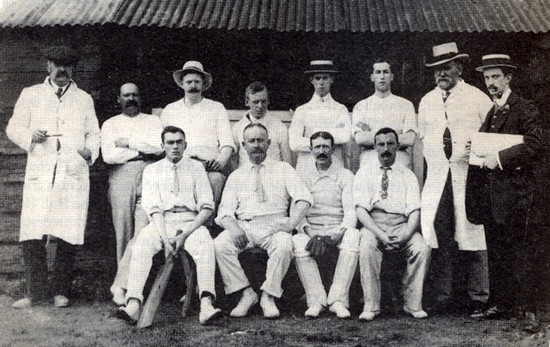
Bourne Cricket Club in 1900
The club persistently attempted to regularise their use of the Abbey Lawn with a written tenancy agreement from the syndicate in an attempt to protect the playing area but this did not materialise and so in 1925, the club purchased 200 yards of wire netting to protect the square. At this time, the football pitch was between the square and the club's score box and the football club were also allowed to use the pavilion during their playing season at an annual rental of £3.
| The football pitch was eventually
moved and the rental was increased to £5 although they made a profit
on this by allowing spectators to use the pavilion as a grandstand.
The cricket pitch was kept in trim purely by voluntary work from the
players on practice nights.
Rolling squads were organised and with the
plantains on the square a constant threat, members armed with
metal skewers pierced the plants and filled the cavities with
petrol, a drastic measure to deter further growth, although tiny
bare patches inevitably appeared afterwards.
One of the clubs best all round cricketers was H S (Horace) Gibbs
(pictured right) from 1922 to 1934, whose most successful season was in 1922 when he scored 817 runs in 14 matches for an average of 72.4. His highest score was 145 in 1925, equalled by Ken Cox at Burghley Park, Stamford, in 1949. |
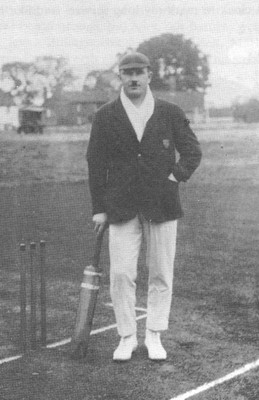
|
The club had a precarious existence during these years and in January 1924 it almost folded through financial problems and lack of support but managed to continue in business. Accounts usually showed that the club was in debt but in December 1924 this did not stop them from taking out a bank overdraft in the sum of £50 to help with the cost of taking up the square, levelling and re-laying turf. A special appeal was launched to meet expenses incurred in improving the ground and the money was successfully raised. This appears to have been a turning point in the club's fortunes and put it on the road to its current success.
At
this time, the Abbey Lawn was owned by a syndicate of local businessmen
who rented out the rights for cricket and football but in
1931, the land was under threat from housing development and was
saved by Bourne United Charities who bought it for £700 to preserve it
for permanent use as
an open space and sports ground. The club made a token contribution of £20 towards the cost. Their first ever cricket week was held
seven years later in August 1938 when club membership stood at 83.
The
Second World War of 1939-45 brought club activities to an abrupt halt but
when play was resumed in 1946, the club's first act was to pay homage to
fallen comrades with a memorial match. The introduction of a full time
groundsman and specialist equipment over subsequent seasons meant that the
Abbey Lawn was beginning to look like the playing surface of today.
The headquarters of the club during this period was at the Angel Hotel but
in 1930, they moved to the Nag's Head which became the club's headquarters
until 1966 when they moved to the newly erected pavilion on the Abbey
Lawn. This was built following the disastrous fire which destroyed the old
premises.
Plans for the new pavilion were soon drawn up and on November 8th, a tender in the sum of £4,428.37 was accepted from Messrs Barnsdale & Sons of Donington, near Spalding, for completion within four months. Progress was on schedule and the new pavilion was opened on 3rd August 1966 by the Earl of Ancaster, the club president. The money had been found through a grant from the Department of Education of Science (£1,555), an insurance claim on the old premises (£1,400) with fund raising and donations from various sources making up the balance. The new building was completed in red cedar with a shingle-type roof and containing all the facilities needed for a modern cricket club, all within eight months, a remarkable achievement.
The opening of the new pavilion was a milestone in the history of the club that has gone from strength to strength ever since. For some seasons past, the Abbey Lawn has been the scene of Minor Counties matches as well as the extremely popular local tournament for the
Hodgkinson Cup, a knockout competition for village teams with matches played midweek in the evenings with a limit of 20 overs per innings.
The club currently runs three senior sides, the first XI playing in the Lincolnshire ECB Premier League of which they were champions in 2000 and 2001, a second XI competing in the South Lincolnshire and Border League Division 1 and a third XI in the South Lincolnshire and Border League Division 3. The club also has a very close relationship with the Motley Crew Cricket Club, a social side playing a collection of week-end and mid-week matches and the home matches are played at the Abbey Lawn
There is also a strong accent on encouraging youth because the club recognises that they will be tomorrow's senior players, There are six youth sides, all under the auspices of the Border Counties Youth Cricket Association, under 17 (Bourne Services Group League - winners 2002 and Vogal Cup; under 15 (Scorer Clay Richardson League and Sun Bank County Cup - winners of both in 2002); under 13 (Doug Druce League - runners-up 2002; under 12 (Warners Midlands League); under 11 (Stamford Mercury Kwik Cricket League - winners 2002; under 9
- (Lady Anne's League - winners 2002.
The club also has a second ground alongside the village hall at Edenham where they currently play their under 12 and under 13 matches.
Major ground improvements were carried out in September
2002 when the square at the Abbey Lawn was upgraded in a two-day operation
by specialist contractors who were well known for their work in improving
sporting surfaces and had been working at Lords earlier in the year. The
project was designed to bring pace and bounce and an improved general
level to the pitch and involved removing three inches of soil from the
surface and replacing it with 46 tons of special loam which was then
laser-levelled to the latest high-tech standards. Six different machines
were used to complete the work which also removed a four inch drop
in the pitch from north to south. Similar improvement work was carried out
at the Edenham pitch, the two projects costing a total cost of £15,000
which has been partly financed with grants from South Kesteven District
Council and from the Sport England/English Cricket Board.
The
club celebrated its bicentenary in the summer of 2003 with a week of
celebrations that included a match with the Lord's Taverners on Sunday
20th July which they won by five runs and raised almost £13,000 for
charity. The visiting team was captained by Chris Tarrant, presenter of
the ITV quiz show Who Wants to be a Millionaire? accompanied by television
actress Lorraine Chase who also played. The following Wednesday, July
23rd, the club played the President's XI, a team of cricketing talent
invited by Terry Bates, the club president, which the club also won by
three wickets with just seven balls left. Terry's side included the
ex-England skipper Mike Gatting and former test colleagues Jim Love, Bill
Athey and Dean Headley, former Zimbabwe captain and coach David Houghton
and West Indian fast bowler Franklyn Rose.
|
 |
|
The club in 1922 -
Back row: The Rev E H Fletcher, R F Carvath,
P Leemdom, W T Peacock, M Crainidge, E R Stark, the Rev Kirby White;
Centre row: J Poole (groundsman), J R Sones (scorer), H S Gibbs, H H
Vickers,
A Minter, H Burbeck, J Fortesque, T Waite (umpire);
Front row: E J Winter, C T Hodgkinson (captain), B Cox, J Fortesque
junior. |
|
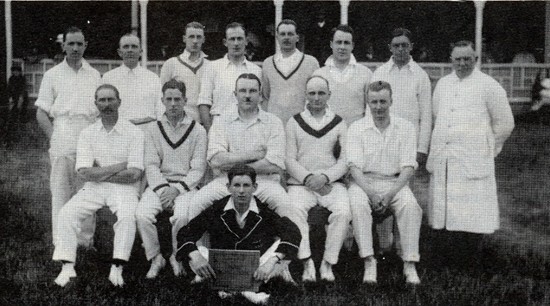 |
|
The club in 1925 - Back row: H Brighton (groundsman), L R A Singthorpe,
W T Peacock, C T Hodgkinson, J A Alderwood, B Cox, H Woolmer, G Evans,
J P Luesby (umpire); Front tow: L Rudkin, F Iliffe, H S Gibbs, the Rev Dr Fletcher, T H Greenwood (vice-captain), R Sones (scorer).
|
|
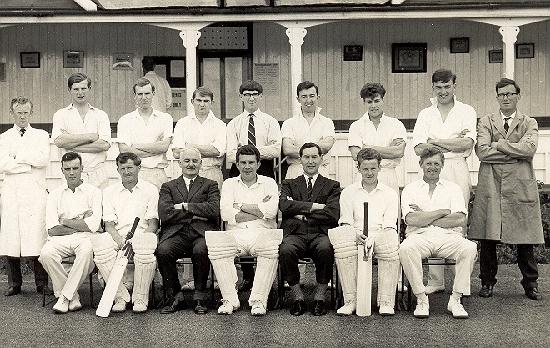 |
|
The 1st XI in 1965 with captain Terry Bates
seated in the centre. The club had four other teams, a 2nd XI,
Sunday XI and Wednesday XI. During the year, the team played 19
games, won eight, drew nine and lost two. This was also the year
that the pavilion burned down. |
|
TWO
DISASTROUS PAVILION FIRES |
|
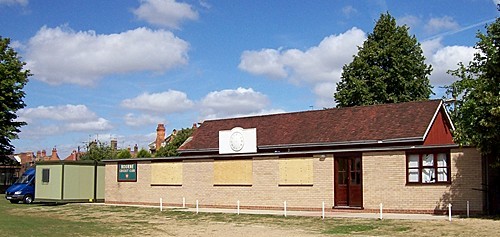
The cricket pavilion pictured after the 2006 fire,
boarded up with
a portable unit brought in as temporary accommodation
FIREMEN were called to Bourne Cricket Club’s
pavilion at the Abbey Lawn in the early hours of Monday 10th July
2006 but despite their efforts, damage running into thousands of
pounds was caused to the bar, lounge, kitchen and changing rooms.
Police originally said that the outbreak had been caused by an
electrical fault but a later investigation by insurance assessors
revealed that it had been started deliberately, one of a series of
incidents of arson and vandalism that had been plaguing the sports
ground for some years. The widespread damage
was a major set back for the
club at the height of the season and on the eve of the 40th
anniversary of the pavilion’s official opening.
The alarm was raised at 3.45 am by a local resident and three fire
crews were soon on the scene but although the building was still
intact, they were unable to save the interior. It was boarded up and
a portable building erected nearby for use as changing rooms by
players for future fixtures until the damage was repaired. All days
games were cancelled because of difficulties with catering but
competition and school matches at weekends continued.
Club secretary David Johnson said later that rebuilding would put
a tremendous strain on their finances because insurance cover would
not meet the entire cost. "The security of the building will also
have to be a lot tighter with barriers and window guards", he said.
"The pavilion will look awful compared to before but that is because
of the society we are living in."
Coincidentally, the new pavilion was built as a result of another
fire that wrecked the old building in the summer of 1965, thus
causing a tremendous upheaval for the club. The pavilion
and changing rooms built in the early years hardly kept pace with
the club’s expansion and in 1965 modernisation plans were afoot but
fate took a hand and speeded up the project. In the early hours of
Saturday 17th July, Mr George Mooney from Middleton, near
Manchester, was driving through Bourne with his family on his way to
the east coast for their summer holidays. The route took him down
Abbey Road and as he passed the cricket ground he saw smoke coming
from the pavilion. He stopped and raised the alarm but by the time
the brigade arrived the wooden building was enveloped in flames and
nothing could be done to save it or the contents.
At the height of the blaze, the brigade, under the command of Sub
Officer Jack Mears, used two powerful water jets but there was a
constant danger from the intense heat generated by the fire and many
of the asbestos tiles were being blown some distance with great
force, several ending up against the wall of the outdoor swimming
pool 160 yards away.
The building was burned down to the brick foundation walls except
for a small section of the kitchen area which was sheathed in metal.
All of the catering equipment, four new dining tables, crockery for
40 people, three complete sets of cricket gear, two dozen tubular
chairs, several deck chairs and 18 new balls (themselves worth £50),
were lost while outside, a semi-circular area extending to more than
20 yards at the front of the pavilion was scorched by the heat. Also
lost in the blaze were the club’s records of score books, match
reports and old photographs.
The cause remains unknown but vandalism was not suspected. The
building was left secure after a Hodgkinson Cup semi-final on Friday
night between Great Ponton and Billinghay but the weekend games with
Oakham II and Egerton Park were cancelled owing to the loss of the
club’s equipment.
Reg Sones, the club’s vice-chairman, surveyed the devastation. “We
feel that part of Bourne has gone”, he said. “While the amenities
were not up to the best standards for our players, the old pavilion
was one of the best in the district and has seen many famous players
in its time. There were plans to upgrade the facilities but these
will now have to be scrapped and we will start again from scratch
and put up a new pavilion.”
The club soon realised that the losses were not entirely covered by
their insurance and within weeks, a Pavilion Appeal Fund was
launched to help cover the cost of rebuilding. A sub-committee was
appointed to prepare the scheme for a new pavilion built of cedar
wood with a shingle roof, containing a members frontage with kitchen
quarters, dressing rooms and ablutions and costing around £5,000.
The design was chosen after a similar structure had been inspected
and approved at Stratford-upon-Avon which, it was decided, would
blend equally well with the Abbey Lawn ground.
The club urged all speed for the project to cater for the growing
number of people who enjoyed their weekends watching cricket and
taking tea on the ground and also to retain an important series of
arranged fixtures, including the Minor Counties match which was due
to take place there that summer.
A letter asking for financial support was circulated throughout the
town and a separate appeal was made to the club’s playing members
which produced a favourable response. Applications were also made
for grant aid to various organisations and local authorities but the
club was deeply aware that it must retain the public’s loyalty. “It
is difficult to design a pattern of development without a strong
basis of local support”, said the letter. “Even without this loss,
had we not had the patronage of many kind people we should probably
have put up the shutters long ago. This situation is no novelty for
cricket has always relied on patronage to maintain a place in the
community and the club will be most grateful to receive any
assistance you may be able to give on this somewhat special
occasion.”
Despite being deprived of the building in mid-season, the club
continued to honour its later fixtures and a marquee was erected on
the Abbey Lawn as a changing room while various premises in the
vicinity were utilised for the serving of teas. |
|
THE CRICKET GROUND FROM THE AIR |
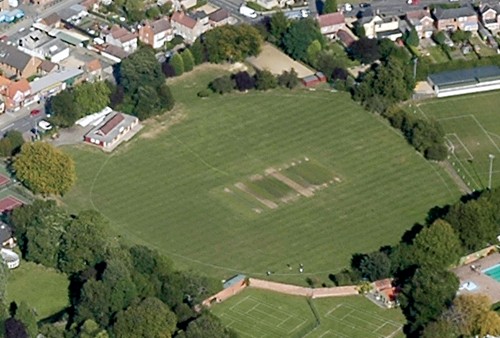 |
|
. . . AND FROM THE GROUND |
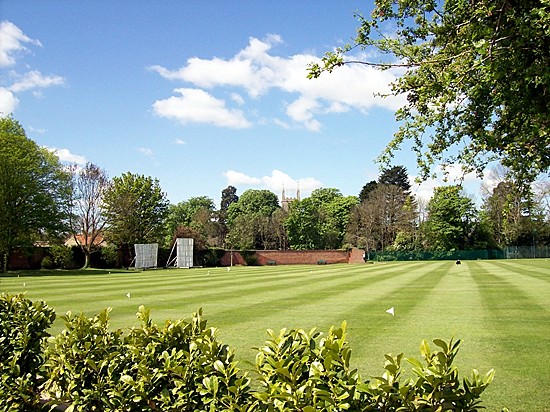 |
|
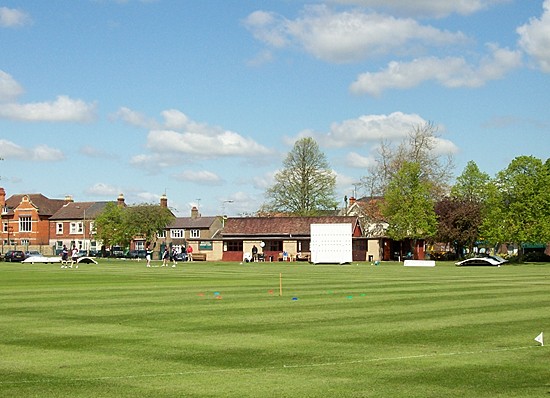 |
|
FROM THE ARCHIVES |
|
The inhabitants of the happy little village of
Irnham, near Bourne, were in their element last week. This village
has long been celebrated for its eminent cricket club and on
Wednesday the 2nd inst., the Hon Mr Clifford (who has not long
resided at the old family mansion there), gave the club a treat as a
finale for the season. Several of their friends were invited from
Bourne and the neighbourhood of Irnham in order to raise a
sufficient number to form a full game and early in the morning,
eleven were speedily arranged on each side for competition. Some
very good batting was exhibited: one party obtained 115 runs in one
innings and against the fine bowling of Mr Phipp. The scene reminded
many of Miss Mitford's happy description of a village cricket match
- none of that petty artifice and low cunning that betting and
blackguardism which too frequently, alas, are the accompaniments of
this manly and truly English pastime, was visible. No. Here was
exhibited all honour and honesty, good play coupled with unanimity
of feeling. During the game, the players, and indeed the whole of
the spectators, were regaled with an excellent cold collation served
up from the hall, the worthy occupant of which, and his lady, were
present during nearly the whole of the game and manifested the
greatest anxiety for the comfort and enjoyment of all present. The
day will not soon be forgotten in this peaceful and domesticated
little village. - news report from the Stamford Mercury, Friday
11th October 1833.
NOTE: Mary Russell Mitford (1787-1855) was a popular
writer of sketches of village life with vividly drawn scenes and
characters based on Three Mile Cross, a hamlet in the parish of
Shinfield, near Reading in Berkshire, where she lived.
The genial weather has given an impetus to the
preparations for the ensuing cricket season. At a considerable
expense, a great improvement has been made in the cricket ground at
Bourne by having the centre levelled and new sodded. It is intended
to commence the season with becoming spirit by a match with the
married and single.
- news report from the Stamford Mercury, Friday 25th April 1851. BANK HOLIDAY AMUSEMENTS: On August Bank Holiday
of previous years, there has been nothing at home to tempt Bourne
people or their friends but this year, we are pleased to say, the
energetic committee of the Bourne Cricket Club have decided not to
allow so important a holiday pass over without some kind of
recreation. At a meeting held on Monday last, it was unanimously
resolved that an old English game of cricket should be played, the
ball to be pitched at eleven o'clock. The teams will consist of the
Bourne club and the H Company, 2nd Volunteer Battalion, Lincolnshire
Regiment. The former will appear in the old English cricketing
costume and the volunteers in uniform. An efficient band, under the
leadership of Mr J G McDermott, of Grantham, will perform during the
match. At 6.30 pm, dancing will commence on the Abbey Lawn ground,
but in the event of the weather being unfavourable this part of the
programme will take place in the Corn Exchange hall. Following
closely in the wake of Whitsuntide, when the holiday traffic in
Bourne was quite unprecedented, it may be fairly assumed that the
last of the summer bank holidays will be less extensively observed.
Spalding, Stamford etc are all preparing to furnish athletic sports;
there is also a cheap day trip to Mablethorpe.
- news item from the Grantham Journal, Saturday 31st July 1886.
The Bourne Cricket Club seems dead, a
correspondent writes us. Although the weather lately has been
against them, yet, wet or fine, they don't seem anxious to turn up
for practice, notwithstanding they are actually down to play
Spalding on Saturday week, some people wonder why Bourne is always
losing. They need practice every day, and then would be scarcely fit
to play such a team as Spalding. Practice makes perfect.
- news item from the Lincolnshire Echo, Friday 1st June 1894. |
REVISED NOVEMBER 2014
See also Bourne
Ladies

Go to:
Main Index Villages
Index
|









